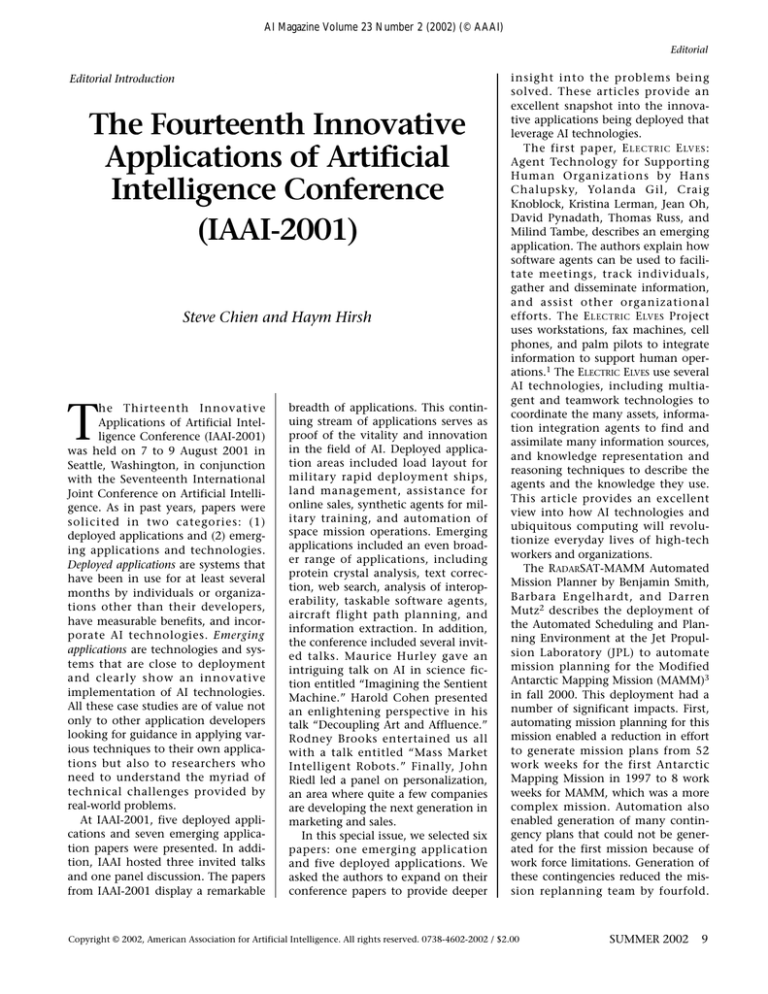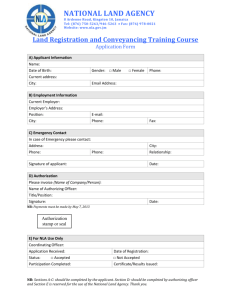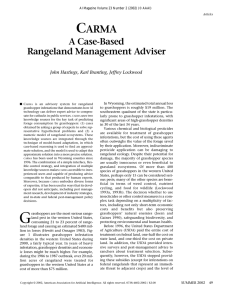
AI Magazine Volume 23 Number 2 (2002) (© AAAI)
Editorial
Editorial Introduction
The Fourteenth Innovative
Applications of Artificial
Intelligence Conference
(IAAI-2001)
Steve Chien and Haym Hirsh
T
he Thirteenth Innovative
Applications of Artificial Intelligence Conference (IAAI-2001)
was held on 7 to 9 August 2001 in
Seattle, Washington, in conjunction
with the Seventeenth International
Joint Conference on Artificial Intelligence. As in past years, papers were
solicited in two categories: (1)
deployed applications and (2) emerging applications and technologies.
Deployed applications are systems that
have been in use for at least several
months by individuals or organizations other than their developers,
have measurable benefits, and incorporate AI technologies. Emerging
applications are technologies and systems that are close to deployment
and clearly show an innovative
implementation of AI technologies.
All these case studies are of value not
only to other application developers
looking for guidance in applying various techniques to their own applications but also to researchers who
need to understand the myriad of
technical challenges provided by
real-world problems.
At IAAI-2001, five deployed applications and seven emerging application papers were presented. In addition, IAAI hosted three invited talks
and one panel discussion. The papers
from IAAI-2001 display a remarkable
breadth of applications. This continuing stream of applications serves as
proof of the vitality and innovation
in the field of AI. Deployed application areas included load layout for
military rapid deployment ships,
land management, assistance for
online sales, synthetic agents for military training, and automation of
space mission operations. Emerging
applications included an even broader range of applications, including
protein crystal analysis, text correction, web search, analysis of interoperability, taskable software agents,
aircraft flight path planning, and
information extraction. In addition,
the conference included several invited talks. Maurice Hurley gave an
intriguing talk on AI in science fiction entitled “Imagining the Sentient
Machine.” Harold Cohen presented
an enlightening perspective in his
talk “Decoupling Art and Affluence.”
Rodney Brooks entertained us all
with a talk entitled “Mass Market
Intelligent Robots.” Finally, John
Riedl led a panel on personalization,
an area where quite a few companies
are developing the next generation in
marketing and sales.
In this special issue, we selected six
papers: one emerging application
and five deployed applications. We
asked the authors to expand on their
conference papers to provide deeper
insight into the problems being
solved. These articles provide an
excellent snapshot into the innovative applications being deployed that
leverage AI technologies.
The first paper, E LECTRIC E LVES :
Agent Technology for Supporting
Human Organizations by Hans
Chalupsky, Yolanda Gil, Craig
Knoblock, Kristina Lerman, Jean Oh,
David Pynadath, Thomas Russ, and
Milind Tambe, describes an emerging
application. The authors explain how
software agents can be used to facilitate meetings, track individuals,
gather and disseminate information,
and assist other organizational
efforts. The E LECTRIC E LVES Project
uses workstations, fax machines, cell
phones, and palm pilots to integrate
information to support human operations.1 The ELECTRIC ELVES use several
AI technologies, including multiagent and teamwork technologies to
coordinate the many assets, information integration agents to find and
assimilate many information sources,
and knowledge representation and
reasoning techniques to describe the
agents and the knowledge they use.
This article provides an excellent
view into how AI technologies and
ubiquitous computing will revolutionize everyday lives of high-tech
workers and organizations.
The RADARSAT-MAMM Automated
Mission Planner by Benjamin Smith,
Barbara Engelhardt, and Darren
Mutz2 describes the deployment of
the Automated Scheduling and Planning Environment at the Jet Propulsion Laboratory (JPL) to automate
mission planning for the Modified
Antarctic Mapping Mission (MAMM)3
in fall 2000. This deployment had a
number of significant impacts. First,
automating mission planning for this
mission enabled a reduction in effort
to generate mission plans from 52
work weeks for the first Antarctic
Mapping Mission in 1997 to 8 work
weeks for MAMM, which was a more
complex mission. Automation also
enabled generation of many contingency plans that could not be generated for the first mission because of
work force limitations. Generation of
these contingencies reduced the mission replanning team by fourfold.
Copyright © 2002, American Association for Artificial Intelligence. All rights reserved. 0738-4602-2002 / $2.00
SUMMER 2002
9
Editorial
The generated plans performed flawlessly during the mission with not a
single spacecraft anomaly because of
flawed plan generation.
Interchanging Agents and Humans
in Military Simulation by Clinton
Heinze, Simon Goss, Torgny Josefson,
Kerry Bennett, Sam Waugh, Ian Lloyd,
Graeme Murray, and John Oldfield
describes the use of agent technology
to assist in training for military operations. This article describes how agents
are used to stand in for humans in AP3C aircraft flight operations. This system has been deployed and is in use
by the Royal Australian Air Force for
both training and development of tactics. In training use, humans can
replace one or more of the software
agents and practice operations in a
wide range of scenarios and simulations. The same software can be used
to develop tactics by implementing
the tactics as the behaviors for software agents and observing the agents
performance over the operational settings of interest. The entire agent,
modeling, and simulation framework
was explicitly designed to facilitate
this important dual use.
CARMA : A Case-Based Rangeland
Management Adviser by John Hastings, Karl Branting, and Jeffrey Lockwood describes an intriguing application of case-based reasoning (CBR)
and adaptation to perform rangeland
management. In this application, an
intelligent system is used to support
pest management, with a focus on
forage consumption by grasshoppers.
In the CARMA system, CBR is first used
to retrieve the closest match to a new
problem. Next, CARMA uses temporal
projection, feature adaptation, and
critical period adaptation to adapt
this case to the current situation.
Temporal projection and critical period adaptation use a rangeland ecosystem model to perform this adaptation. In a true showcase of AI
flexibility, CARMA has also been used
to support decision making other
than rangeland management, including evaluating disaster areas, determining policies for pesticide use, and
researching pest management.
NATURAL LANGUAGE ASSISTANT—A Dialog System for Online Product Recommendation by Joyce Chai, Veron-
10
AI MAGAZINE
ika Horvath, Nicolas Nicolov, Margo
Stys-Budzikowska, Nanda Kambhatla, and Wlodek Zadrozny describes a
system to help users find product
and service information in electronic-commerce sites. The NATURAL LANGUAGE ASSISTANT ( NLA ) uses natural
language processing to derive concepts of interest to the user. NLA then
uses a concept hierarchy knowledge
base to direct the user to the appropriate information. Several studies
have shown that users prefer the NLA
approach to menu-driven navigation
systems. NLA also offers advantages
over traditional text search and keyword-matching approaches in that it
uses semantic knowledge to perform
additional filtering, thus enabling
NLA to be more likely to find useful
information. The NLA application
provides an excellent view into the
synergies and opportunities at the
intersection of AI and electronic
commerce.
TALPS : The T- AVB Automated Load
Planning System by Paul Cerkez
describes the use of rule-based systems to encode a constraint-based
approach to layout of military loads
in T-AVB rapid-deployment ships. TALPS
encodes constraints such as space,
electrical system access, hatches, and
equipment access, that influence
search. TALPS also encodes heuristics
in the form of default configurations.
TALPS then uses information about the
specific ship being loaded and load
containers to rapidly develop a load
plan. This system is currently in use
by U.S. Marine Corps Aviation to
develop load plans.
These six articles provide a good
sampling of current applications that
are making or might soon make a difference in lives of non–AI practitioners. In some of these articles, AI technology plays a central role. In others,
AI is a key part of a larger system. In
all cases, the application provides an
interesting perspective on how AI
technologies must be adapted and fitted into a larger operational context.
These applications document the
diverse range of problems that AI
technology is solving in today’s
world. We in the AI community can
take pride in these innovative applications and look ahead to even more
fascinating and effective uses of AI
technology in the future.
Acknowledgments
We thank the authors for their efforts
in rewriting and expanding their conference papers. We also thank the
IAAI-2001 program committee members for their help and expertise in
the selection of papers and the formation of the rest of the conference:
Bruce Buchanan, Bob Engelmore,
Usama Fayyad, Ronen Feldman,
Randy Hill, Neil Jacobstein, Craig
Knoblock, Alain Rappaport, Charles
Rosenberg, Ted Senator, Howard
Shrobe, Reid Smith, Shirley Tessler,
and Sam Uthurusamy. Thanks are
also owed to the office staff of AAAI
for their outstanding and continual
support and to David Leake and Mike
Hamilton of AI Magazine.
Notes
1. www.isi.edu/e-elves/.
2. aspen.jpl.nasa.gov.
3. www-aig.jpl.nasa.gov/public/planning/mamm/.
Steve Chien is technical
group supervisor of the
Artificial Intelligence
Group and prinicipal
computer scientist in
the Exploration Systems
Autonomy section at the
Jet Propulsion Laboratory, California Institute of
Technology, where he leads efforts in automated planning and scheduling for space
exploration. Chien is also an adjunct associate professor at the University of Southern California. He holds a B.S. with highest honors in computer science, with
minors in mathematics and economics, an
M.S., and a Ph.D. in computer science, all
from the University of Illinois. Chien was
cochair of IAAI-2001.
Haym Hirsh is associate
professor of computer
science at Rutgers University. His current research concerns the
application of machine
learning and information-retrieval methods
to tasks involving information access and human-computer interaction. He received his B.S. in 1983 from
the University of California at Los Angeles
and his M.S. in 1985 and Ph.D. in 1989,
both from Stanford University. Hirsh was
chair of IAAI-2001.


